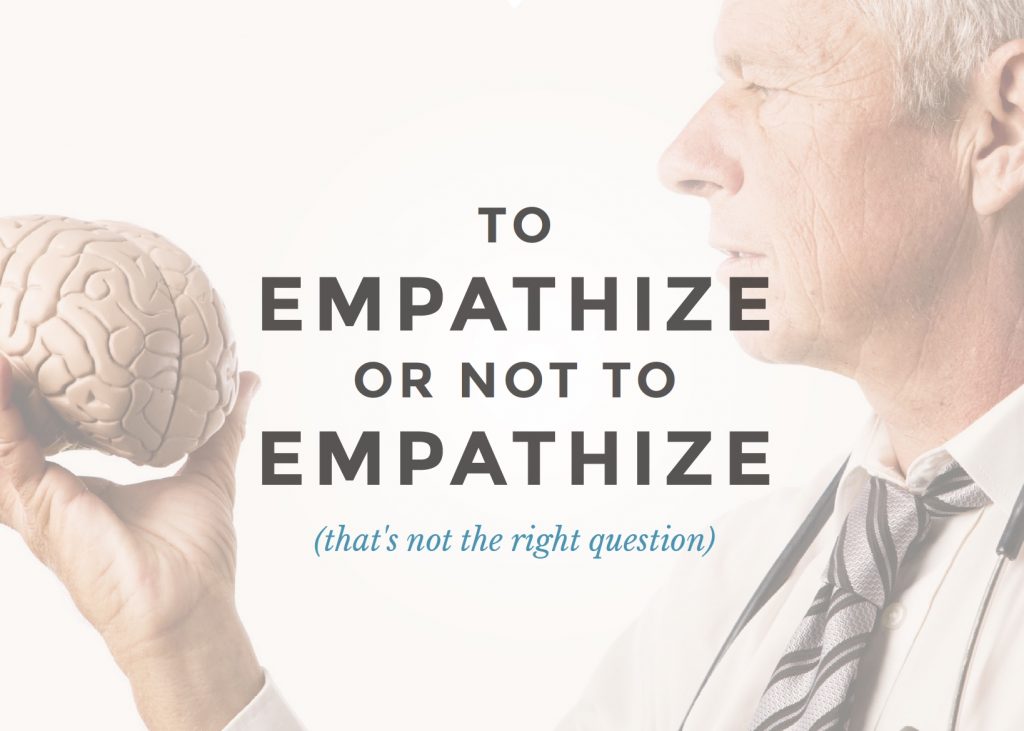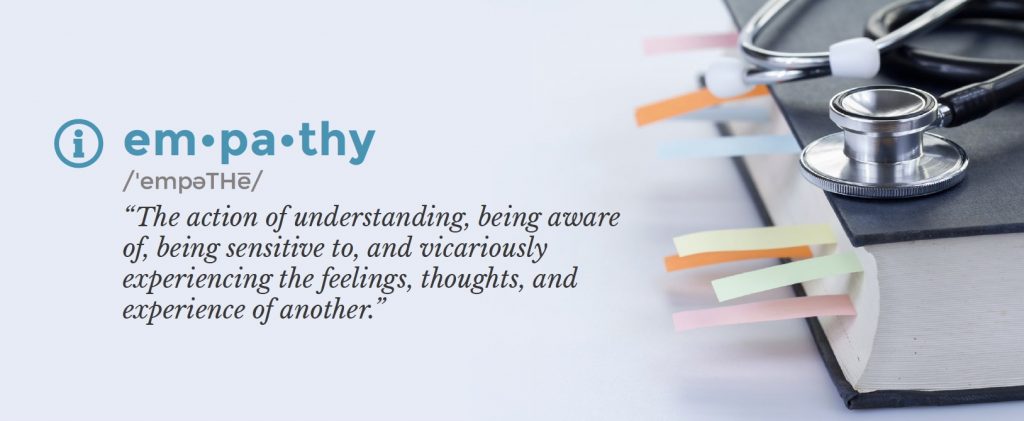To Empathize or Not to Empathize
To Empathize or Not to Empathize
(that’s not the right question)

The headline on ScientificAmerican.com said it all: “Why Doctors Should Be More Empathetic—But Not Too Much More.” According to the post, recent brain-imaging studies showed that while physicians felt less empathy than non-physicians when watching painful medical procedures, their brains also “showed significantly greater activation of areas involved in executive control, self-regulation and thinking about the mental states of others.” The Scientific American authors conclude that there is a necessary trade-off in medicine between feeling and thinking, “because the human brain does not have infinite computational resources or time to perform both tasks equally well. One must be caring while also figuring out a proper diagnosis, prognosis and treatment, often under conditions of uncertainty.” Their advice: physicians should aim “to find the right balance, the golden mean that optimizes care.”
While the brain scans add a high-tech gloss to the discussion, the idea that thought and feeling are opposed to each other is nothing new. And the prescription, “knowing when empathy is called for and when it is detrimental,” is less than helpful, especially when both empathy and reasoning are often called for in the same setting. Studies have shown, for instance, that a sound diagnosis demands both emotional connection and deductive logic. Without the former, patients are less likely to share important information and doctors are more likely to miss important emotional cues. Without the latter, no amount of information can lead to a sound diagnosis.
Complicating the issue still further is the need to find a balance between too much empathy and too little. Too much empathy and a physician’s emotional connection to a patient can all too easily drift over the boundary that separates the professional from the personal. A boundary violation often follows. And even when intense empathy doesn’t cross the line, feeling too much for patients can lead to emotional exhaustion and burnout.

Paradoxically, both problems—boundary violations and burnout—can also be caused by a lack of empathy. Dr. Stephen Schenthal, founder and CEO of Professional Boundaries, Inc. (PBI), has seen cases in which brilliant but socially awkward clinicians, who don’t relate well to others, end up being accused of inappropriate behavior. “Patients can become uncomfortable when being examined by someone they perceive to be unfriendly or mechanical. And routine questions or comments can seem intrusive or aggressive if the physician sounds too detached.”
In addition, notes forensic psychiatrist Funmilayo Rachal, a clinician’s lack of empathy can cause patients to feel disconnected from their treatment. That, she says, “can increase the risk of liability. If there is an adverse outcome, the patient may be more likely to be litigious if they feel the physician is not being empathetic.”
And physicians who lack empathy also suffer from burnout, says Rachal. Physicians who shut down any emotional connection to their patients often lose a sense of purpose and end up feeling dehumanized. “They become disengaged, and that creates more lack of personal satisfaction and lack of personal accomplishment, which leads to burnout.”
WHAT’S IN A NAME?
In an effort to solve the challenges posed by empathy, the medical community has sometimes stretched the meaning of the word beyond recognition. The dictionary definition of empathy reads in part, “the action of understanding, being aware of, being sensitive to, and vicariously experiencing the feelings, thoughts, and experience of another.” But in a 2003 article entitled “What is Clinical Empathy,” Jodi Halpern notes that throughout the 20th century medical literature has drawn an odd line between sympathy and empathy. Sympathy is defined as a potentially dangerous emotional identification with another, whereas empathy is perversely defined as a “purely cognitive.” The term of art is “clinical empathy,” and according to Halpern, “Influential articles in the ‘The New England Journal of Medicine’ and the ‘Journal of the American Medical Association’ in the 1950s and 1960s argue that clinical empathy should be based in detached reasoning.” A group from the Society for General Internal Medicine goes so far as to define empathy as “the act of correctly acknowledging the emotional state of another without experiencing that state oneself.”
But redefining empathy as detached reasoning does not resolve the conflict. Whatever you call it, what patients clamor for, and what benefits both patients and clinicians, is an emotional connection. The challenge is finding a way to achieve such a connection without falling victim to either a boundary violation or burnout.
The solution goes by many names. Peter Graham, co-founder of Acumen Assessments and Acumen Institute, describes it as higher-order empathy. “Empathy involves two levels,” he explains, “being able to imagine the subjective emotional experience of another person from their perspective, while simultaneously being able to maintain your own separate feelings and perspective.” When dealing with a patient who is “exuding this affect and these feelings,” says Graham, the physician has to “accurately identify with that, understand where it’s coming from, but at the same time maintain a doctorly perspective with the specific intention of a physician, which is to care for the patient.”

“Every school of thought in psychology and psychiatry has their own language for this mental position,” notes Graham. Some psychoanalytically oriented researchers use the term “mentalization,” while others talk about “emotional intelligence” or “reflective functioning.” Each of these approaches is distinct, but all highlight the desirability of emotionally understanding both what someone else is feeling and what you yourself are feeling, and the importance of maintaining a clear separation between the two.
As difficult as it is to achieve this dual awareness, the fact is that people have been doing it for thousands of years. Buddhist monks are able to care about and care for others, to emotionally connect with people in pain and maintain the distance needed to help relieve their pain. Tania Singer, professor of Neuroscience and Neuro-economics at the University of Zurich, conducted brain scans of both Buddhist monks and non-meditators as they watched videos of people suffering. According to an article in Wired magazine, the fMRI scans of the monks’ brains “showed heightened activity in areas that are important to care, nurturing and positive social affiliation. In non-meditators, the videos were more likely to trigger the brain areas associated with unpleasant feelings of sadness and pain.”
This ability to emotionally understand what another is feeling, while at the same time focusing on ways to help, has roots even deeper than the Buddhist tradition. One monk compared what he felt while watching the videos to “the warm, loving, caring feeling” that a mother feels towards a crying child—the ability to feel a strong emotional connection and maintain the distance needed to provide care.
SETTING BOUNDARIES IS ESSENTIAL TO HEALTHY EMPATHY.
“When I’m treating clinicians who struggle with empathy, part of what I do is focus on how to get healthy boundaries,” says Rachal, “which can be hard for some physicians.”
Establishing and maintaining clear boundaries between the personal and professional spheres is crucial. “Part of being a doctor involves protecting yourself,” notes Graham. “It involves setting boundaries so that you have time to have a private life, where you can have a differentiated self.” It’s only by having a range of different experiences— as a doctor, a parent, a child, a friend and a neighbor, for instance—that you can access different perspectives.
“Part of what we teach people is that you have to live your life in such a way that maintaining that two-part perspective is possible,“ explains Graham. “If the only experience you have when you’re awake is working with patients, dealing with suffering, and you don’t have time and the opportunity to have alternative experiences, then all that’s left is constant immersion. The doctor who’s always on call has no chance to experience a different perspective on the world.”
Well-maintained boundaries also allow physicians to take crucial time for themselves, so they can recharge their batteries. It takes a good deal of emotional strength to hold on to your own perspective while listening to and empathizing with patient after patient. “That’s why it’s so important for physicians to get away from work and rejuvenate themselves, says Graham, “to take the time to think and talk to other people about the reality of what they are going through.”
